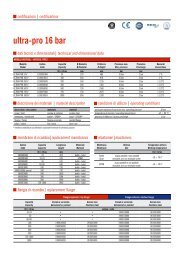PDF file - Zilmet USA
PDF file - Zilmet USA
PDF file - Zilmet USA
Create successful ePaper yourself
Turn your PDF publications into a flip-book with our unique Google optimized e-Paper software.
heating<br />
cal-pro<br />
Application: expansion vessels for heating systems.<br />
general features<br />
Advantages:<br />
<strong>Zilmet</strong> has over 50 years of experience in manufacturing high quality diaphragm expansion tanks<br />
• Over 2 million square feet of production space<br />
• Has produced over 7.5 million tanks and over 1 million heat exchangers<br />
• Fully vertically integrated, designing and manufacturing all diaphragms internally<br />
<strong>Zilmet</strong> has created a compact design with a seamless diaphragm that never stretches or creases.<br />
There are no bubbles or corners to trap sediment, inhibiting bacterial growth<br />
• Wide range available (from 2 to 184 gallons)<br />
Technical Features:<br />
• Each tank is factory leak tested to ensure tank integrity<br />
• Certified synthetic SBR rubber diaphragm<br />
• All diaphragms designed to maximize drawdown<br />
• MIG welding eliminates interior rough spots and sharp edges<br />
• Welded side outlet allows easy and quick installation<br />
• Low pro<strong>file</strong> tank design with full membrane depth eliminates stretching of diaphragm,<br />
providing increased life cycle<br />
• External baked on epoxy-polyester coating provides a durable, appliance like finish<br />
• Protected pre charge valve eliminates potential leak path<br />
• 5 year warranty on all models<br />
• Tank customization available upon request<br />
Operation<br />
In a closed heating system water cannot be compressed and any increase in water volume due to the increase<br />
of its temperature is absorbed by the expansion vessel. When water is cold, the precharge pressure of the tank<br />
presses the diaphragm against the tank. As temperature increases, the expanded water volume pushes against the<br />
membrane and water enters the tank, providing additional space to the system. With the temperature decrease, the<br />
air cushion forces water back into the system. This permits the system to maintain the pressure, helping to reduce<br />
energy consumption of the heating system.




